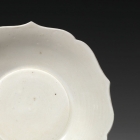J.J. Lally & Co., Oriental Art / New York City, New York
MenuPast Exhibition
EARLY CHINESE WHITE WARES
The Ronald W. Longsdorf Collection
September 11 - October 3, 2015
16.
A PENTAFOIL DISH WITH BARBED RIM
Late Tang Dynasty-Five Dynasties, A.D. 10th Century
Ding kilns
with shallow rounded sides flaring out from the plain central medallion and rising to a lipless rim neatly pared into five wide lotus-petal brackets, covered with a lustrous clear glaze inside and out, showing ‘tear marks’ on the underside where the glaze shades to a yellowish-ivory tone, and resting on a slightly splayed high ring foot of wedge-shaped cross section, the glaze ending low on the sides, leaving the foot and base unglazed revealing the fine white porcelain.
Diameter 6 1⁄4 inches (15.9 cm)
Five-pointed dishes of this type are the rarest of the barbed rim category.
An early Dingyao pentafoil dish of very similar form in the Meiyintang Collection is illustrated by Krahl, Chinese Ceramics from the Meiyintang Collection, Volume One, London, 1994, pp. 198-199, no. 346, where the author mentions a five-pointed porcelain dish excavated at the site of the Ding kilns at Jiancicun, Quyang county, illustrated in a line drawing by Watson, Tang and Liao Ceramics, London, 1984, p. 119, fig. 6p. The same dish from the Meiyintang Collection was exhibited at the Musée Cernuschi and illustrated by Krahl in the catalogue L’âge d’or de la céramique chinoise, Paris, 1999, pp. 42-43, no. 21.
Compare also the early white porcelain pentafoil dish on small ring foot discovered in the foundation crypt (di gong) containing dedication gifts beneath a Liao dynasty Buddhist pagoda at Daliang, Wuqing district, Tianjin, Hebei province, illustrated by Zhang (ed.) in Zhongguo chutu ciqi quanji (Complete Collection of Ceramic Art Unearthed in China), Vol. 2: Tianjin, Liaoning, Jiling, Heilongjiang, Beijing, 2008, p. 9, no. 9.
晚唐-五代 定窰白瓷五瓣稜口盤 徑 15.9 厘米
